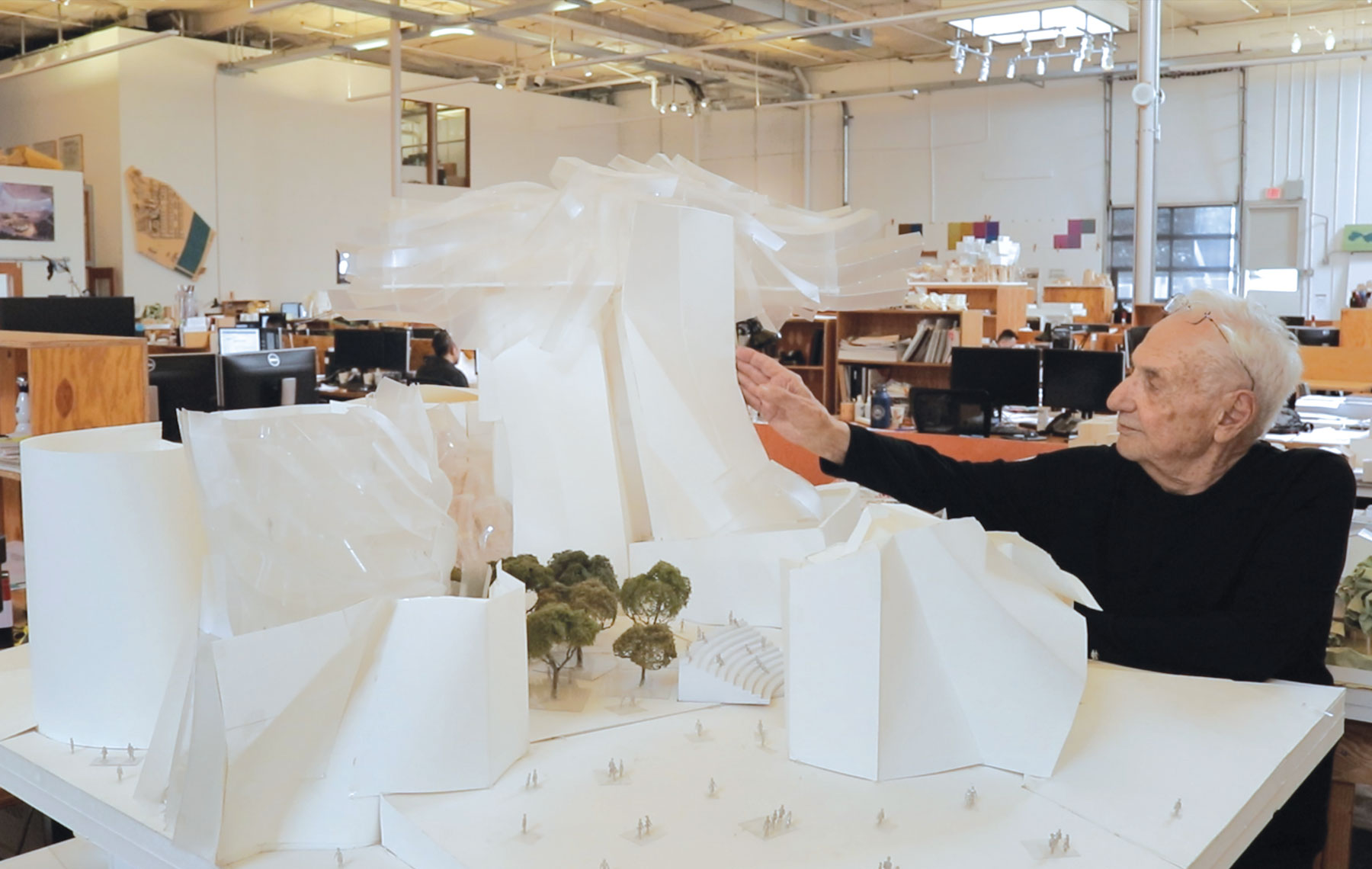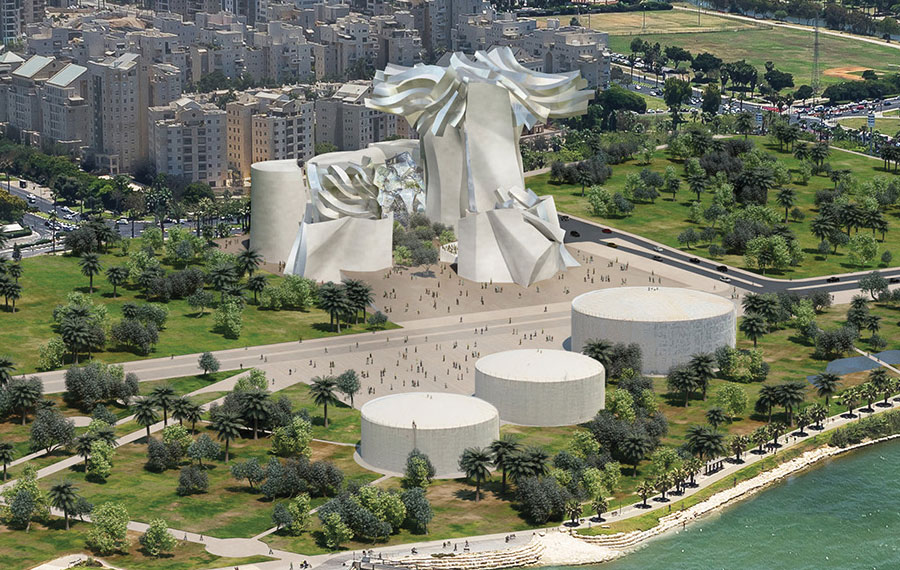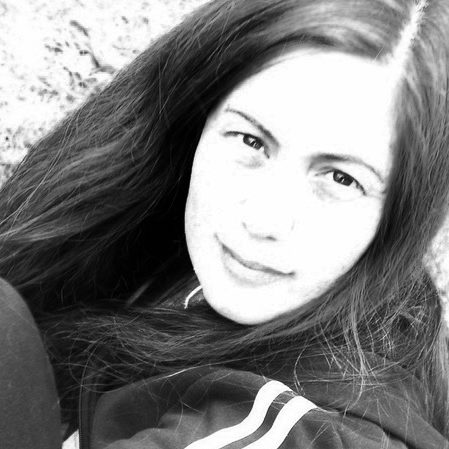 Frank Gehry in his Playa Vista office.
Photo by Armando Koghan
Frank Gehry in his Playa Vista office.
Photo by Armando Koghan Sunlight streams through the skylight in the space that serves as a boardroom in Frank Gehry’s sprawling offices in Playa Vista. The room is filled with mementos and photographs taken with famous people that speak to the 90-year-old architect’s renown that spans decades and continents.
As Gehry ambles into the room via a sliding glass and wooden door that opens onto his company’s cavernous workspace filled with busy architect bees, he pumps his left fist in the air and declares, “I’m an atheist!”
This opening statement, as the unfolding interview will attest, is no random pronouncement. Gehry knows this is an interview being conducted by a Jewish paper about his design for the $300 million World’s Jewish Museum, slated to open in Tel Aviv in 2023 to coincide with Israel’s 75th anniversary of independence.
The museum will span 5 1/2 acres and overlook the Mediterranean. Once complete, it will connect Hayarkon Park, the Mediterranean Sea and anchor the Tel Aviv North development. It aims to become an iconic cultural draw highlighting Jewish accomplishments.
Yet throughout the hourlong interview, Gehry makes it clear this project is not about returning to his Jewish roots, which he admits he abandoned during the reception immediately after his bar mitzvah.
“I found the people disingenuous at my bar mitzvah,” he says by way of explanation. “It was a small shul in Toronto. My grandfather was the president of the congregation. I worked hard on the piece I had to study and read and afterward I started talking to some of the people in the congregation about it. They didn’t know what I was talking about. They were just there for the schnapps and the food, and [they] split. I said, ‘Wait a minute.’ So I talked to my grandfather. He was more interested in the principles and the humanity [in Judaism].”
“I’ve always been looking for a way to avoid decoration and we’re living in a world where everything’s in motion and I thought maybe if you expressed motion in architecture, that would create feeling that would be relevant.” — Frank Gehry
And that, in a nutshell is how Frank Gehry became an atheist.
And yet, Gehry is a delightful conundrum — an interlocking mental jigsaw puzzle that doesn’t follow any predictable form (much like his architectural designs). It’s how he is capable of denouncing any connection to Judaism yet still counts the Talmud as a major source of inspiration.
“The Talmud starts with the word ‘why,’ ” he says. In fact, on the model of the museum sitting in his offices, the word “why” in Hebrew (Lamah) is carved into one of the buildings, although he says he doesn’t know if that will be included in the final construction.
“There’s a curiosity built into the [Jewish] culture,” he explains. “I grew up under that. My grandfather read Talmud to me. That’s one of the Jewish things I hang on to probably — that philosophy from that religion. Which is separate from God. It’s more ephemeral. I was brought up with that curiosity. I call it a healthy curiosity. Maybe it is something that the religion has produced. I don’t know. It’s certainly a positive thing.”

Which raises the question: If Gehry (born Frank Goldberg) doesn’t identify as Jewish, why take on a uniquely Jewish project in the Jewish homeland?
The decision, he explains, has far more to do with fellow Canadian Gail Asper of the Asper Foundation, the visionary behind the museum. Gehry signed onto the project because of Asper’s vision. “I liked her,” he states matter-of-factly. “She spent time with me and told me what her dream was.”
That dream includes a place that highlights contributions by the Jewish people to the world. What clinched the deal for Gehry was when Asper showed him the Canadian Museum for Humans Rights in Winnipeg, Manitoba. Initially conceived by Asper’s late father, Izzy Asper, Gail spearheaded the project after her father died suddenly in 2003. The museum officially opened in 2014 and has since become a world-renowned, must-visit destination.
A major part of the Human Rights Museum’s draw is the stunning structure designed by Albuquerque, N.M., architect Antoine Predock. Gehry says after seeing the Human Rights Museum, “it was clear [Asper] understood architecture and the power of architecture and that what she was trying to accomplish with it [in Tel Aviv] seemed like a reasonable mission.”
“There’s a curiosity built into the [Jewish] culture. I grew up under that. My grandfather read Talmud to me. That’s one of the Jewish things I hang on to probably.” — Frank Gehry
More importantly, Asper “had a passion that seemed real. It was clear to me that Gail wanted to have a building that could do what Bilbao did,” he adds, referring to his Guggenheim Museum in the northern Spanish city of Bilbao, which opened in 1997. “It will open the eyes of where the building becomes part of the art, part of the story, and so it couldn’t just be a box.”
Gehry believes the World’s Jewish Museum will help Asper tell her story — “a building that will become [something] that the people of Tel Aviv will be proud of and it will be a positive story about what Jews accomplished under duress in many cases.”
In a phone interview with the Journal while visiting Gehry’s office, Asper says, “The site will have the greatest story that’s never been told about the Jewish people. It will celebrate the joys, not the oys. [The museum] is more about how Jewish values have transformed and improved the world.”
For Asper, having Gehry bring her vision to fruition “is like hearing angels sing,” she says. “Frank immediately loved the vision. I know that beautiful architecture inspires the soul and Frank [designs] incredibly breathtaking, inspiring buildings. I love Bilbao. I love the Disney Concert Hall. I love what he does. And for all the countries in the world to not have some extraordinary breathtaking Frank Gehry building, Israel absolutely deserves that. And Israelis deserve that. They put up with an awful lot living in Israel. They pay high taxes. They’re dodging rockets, even in Tel Aviv.”
Of Gehry’s design, Asper says, “The one we chose is breathtaking [and] in keeping with the white city [of Tel Aviv]. Frank is iconic and beautiful. People have such challenging lives, it’s a gift to be able to give them something beautiful.”
The gleaming white and glass design comprises a series of buildings, one of which looks like leaves coming out of the top of a tree.
“It’s a simple program,” Gehry explains. “It’s galleries and a library and an auditorium and a restaurant and a public meeting space. It seemed logical to put the restaurant and the public meeting space on top so they get the view. And to use the auditorium as a way to enclose the public space and create a garden with the elements. So it’s kind of a private entrance garden people could meet and spend time in.”
As to the glass and “tree-like” elements of the project, Gehry explains: “I’ve always been looking for a way to avoid decoration and we’re living in a world where everything’s in motion and I thought maybe if you expressed motion in architecture, that would create feeling that would be relevant.”

He adds how important it is to him that when you enter a space, it evokes certain feelings. “So I thought certainly a museum for a program like this should have a character to it and I didn’t want to use decorative elements from the 19th century. So it’s easier to make a restaurant more flamboyant. It could be built with glass and we’ve done a lot of experimenting with that and our hope is to be able to have a building that’s expressive on the skyline but also is very special to be inside.”
The interior is the purview of Ralph Appelbaum, whose company Ralph Appelbaum Associates will helm the exhibits. Appelbaum is world-renowned for curating some of the most iconic museums around the world, including the Smithsonian National Museum of African American History & Culture in Washington, D.C., the Canadian Musuem for Human Rights in Winnipeg, the United States Holocaust Memorial Museum in Washington and the Jewish Museum and Tolerance Center in Moscow. He’s currently working on Barack Obama’s presidential library in Chicago.
“We’ve won over 40 national and international awards for the [Human Rights Museum],” Asper says. “[Appelbaum] is in over 700 museums around the world and he’s the best idea museum guy.”
Among those on the Tel Aviv museum’s prestigious advisory council are Rabbis David Wolpe and Joseph Telushkin; author and nationally syndicated radio host Dennis Prager; Malcolm Hoenlein, executive vice chairman of the Conference of Presidents of Major American Jewish Organizations; and Israeli historian and writer Fania Oz-Salzberger, all of whom will have a hand in shaping the vast project.
The project will include the museum’s “Genesis Garden,” the Grand Lobby and six pavilions: the Covenant & the Land of Israel pavilion will be a multimedia experience, introducing the foundations of Jewish thought and values; the Creativity pavilion will showcase the impact of Jewish culture and its contribution to the arts; the Enterprise pavilion will be a retrospective of how Jewish professions evolved as a result of segregation, anti-Semitism and constant displacement, and will include stories of the development of the world’s first stock exchange, the film industry, the comic book industry, the success of today’s Startup Nation and the global impact of Jewish business icons, including its mobsters and oligarchs; the Science & Inquiry pavilion will look at how Jewish ideas and values have led to transformative contributions to science, medicine and technology; the Philosophy & Education pavilion will highlight how Jewish continuity, even Jewish uniqueness, depends not on central places, monuments, heroic personalities or rituals but rather on written words and an ongoing debate between the generations; and the Tzedek, Tikkun Olam & Tzedakah pavilion will highlight ways for people to engage in philanthropy and social change.
“The site will have the greatest story that’s never been told about the Jewish people. It will celebrate the joys, not the oys.” — Gail Asper
“I think [the museum] can be an important message for the world that a lot of people accomplished many things in the fields of science and art and education and all the important topics we live by and we are inspired by,” Gehry says.
So how do you physically design a Jewish museum that doesn’t incorporate references to the Holocaust?
“I think there is an important story to be told about these people,” Gehry says of the Jewish people. “Their beliefs, their upbringing, their inspirations and aspirations and their accomplishments. I think that there is something going on in the world that brings these people to the fore.”
And while this is Gehry’s first building in Israel, it’s not the first time he’s been asked to design a project in the Jewish state. In 2004, he signed on to design the Museum of Tolerance in Jerusalem. In 2010, he pulled out of the project, which is now being designed by Israeli architect Moshe Safdie. Officially, Gehry resigned because of “financial issues.” In this interview, the response is, “I don’t want to talk about that.”
However, he is willing to say, “I’ve had so many funny relationships with Israel about buildings. I don’t know if I’d accept a project in Israel other than this one. I had bad experiences, one after another. I’m not excited about going there. I’m excited about doing a building with Gail, and her mission is something I believe in. [The museum] will be a positive story about what Jews accomplished under duress in many cases, with a lot of misunderstandings and bad stuff happening through the Holocaust.”
The Holocaust is also something Gehry doesn’t really want to talk about “especially as it seems to keep happening in one form or another.” However, he then adds, “I lost 33 family members in Auschwitz. I didn’t know them and that was just my mother’s family. So you hope that kind of stuff isn’t repeated; that people find a pride in their own history. That includes the art and architecture, music, certainly. My heroes are [conductor] Zubin Mehta and [former Israeli Prime Minister] Shimon Peres.”
Gehry points to a photograph hanging on a wall featuring him and the late prime minister. Peres became a close friend and Gehry says that was one positive thing that came out of signing on to do the Jerusalem Museum of Tolerance project.
“He was a good friend and he talked to me about architecture,” Gehry recalls.
“The interior is the purview of Ralph Appelbaum, whose company will helm the exhibits. Appelbaum is world-renowned for curating some of the most iconic museums around the world.”
“There was a dinner in Jerusalem to announce the Museum of Tolerance building. I was seated between [former Prime Minister] Ehud Olmert and Shimon Peres. That afternoon I was at the Israeli president’s [Moshe Katsav] house and presenting the model, and while I was talking, I said, ‘Excuse me a minute. I have to talk to my grandfather.’ ” Gehry pauses, raises his eyes heavenward, and continues: “I said, ‘Zayde, I’m in the president of Israel’s house and I’m presenting a model for a museum in Jerusalem and I’m standing between Shimon Peres and Ehud Olmert!’
“[Peres] gave me a 20-minute intro and he knew all about my architecture, which was very moving, and he would invite me whenever I was in Israel to be with him. And he came [to Los Angeles] a few months before he died and asked if he could come by my office.”
Gehry also speaks fondly of Olmert’s wife, Aliza, an artist in her own right and a patron of the arts in Israel. He points to a horizontal painting of trees done by her on a wall of his office and says, “I have my ties and feelings about [Israel] that are related to [Aliza] and Shimon and Moshe Safdie.”
And it’s art — not religion — that has seen Gehry talk about wanting to possibly design a synagogue some day. “You’re talking about a transcendent space,” he says. “Creating a feeling that takes you somewhere. I think that I look at religion as trying to find your place in the world. You’re trying to put yourself in a place and when you go out into nature, your feelings are brought out and it’s fascinating to try to capture that feeling in a building. Very few have done it. The old cathedrals have done it. That’s what I’d like to try and think about. I don’t care what religion it is.”
And then, without pausing for breath, he adds, “I love hearing the Kol Nidre when it’s done well, so every once in a while I go and hear it if they’ll let me in.” He turns to his assistant and asks, “What’s that one place I like where I went?”
It becomes clear that Gehry attended Kol Nidre services at IKAR, led by Rabbi Sharon Brous. “Yes,” he says. “IKAR. [Brous] did talk to me a long time ago about doing something. I’m ready if she is. I like her a lot!” (Editor’s note: IKAR already has hired another architect to design its new space.)
Gehry is passionate about putting art back into architecture. “The issue for architecture is that historically, it was considered an art, and since the war, since modernism, it got mixed up with other issues like commercial developers. It slowly became just stupid,” he says.
That, he adds, has led to artists “and a lot of the world no longer considering architects [as] artists. So I think what’s needed is architects who are artists.”
And the World’s Jewish Museum aims to be an architectural piece that is also a piece of art. And while the Museum of Tolerance project in Jerusalem may not have panned out for him, Gehry’s excited about the Tel Aviv project.
“Modernism was built in Tel Aviv,” he says, referencing the late Israeli architect Ram Karmi, known for his brutalist style and designing, among other iconic buildings, Israel’s Supreme Court building. “His sister [architect Ada Karmi-Melamede] is doing interesting work. I think [architecture] is less loaded in Tel Aviv. It seems to be freer.”























 More news and opinions than at a Shabbat dinner, right in your inbox.
More news and opinions than at a Shabbat dinner, right in your inbox.